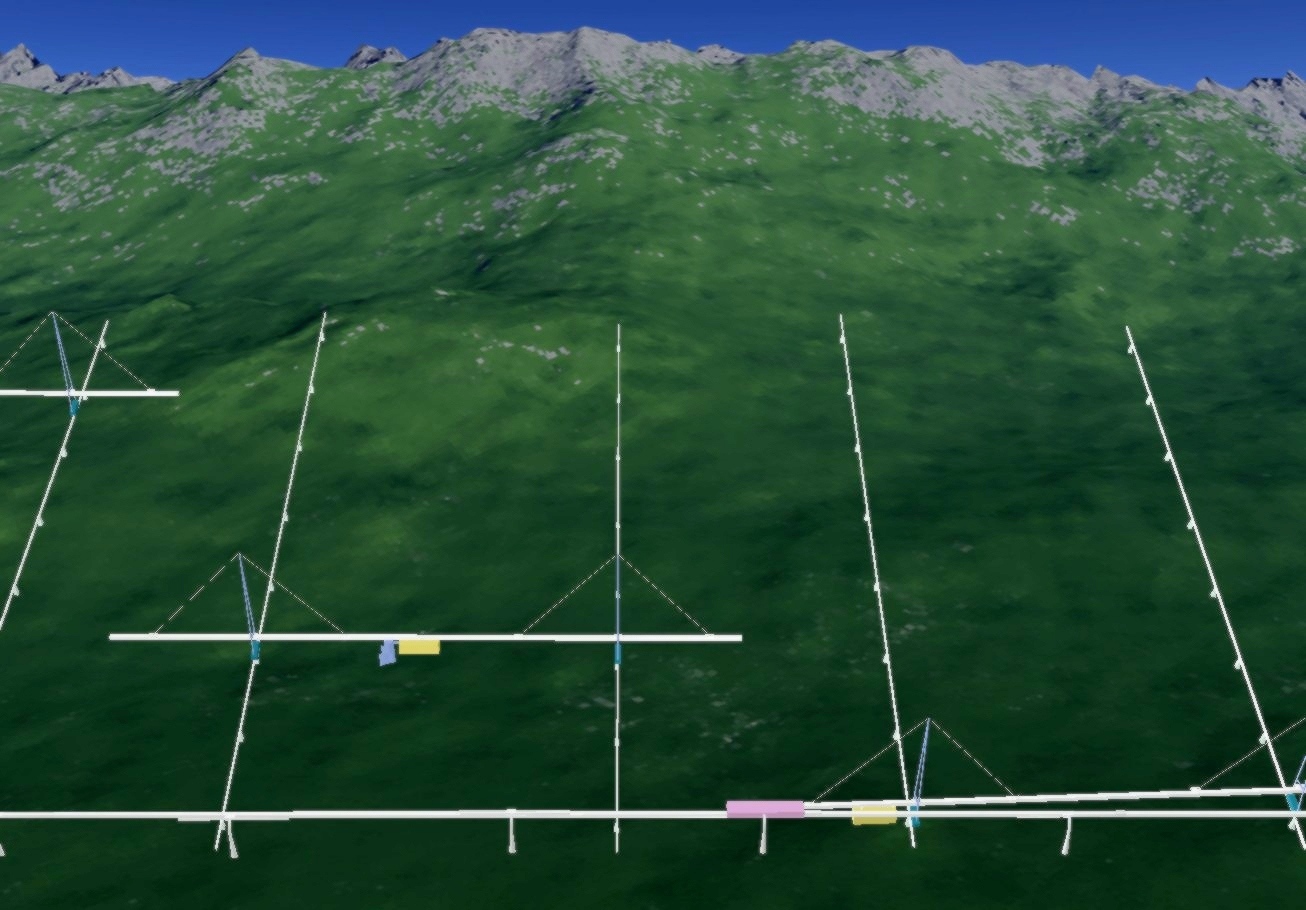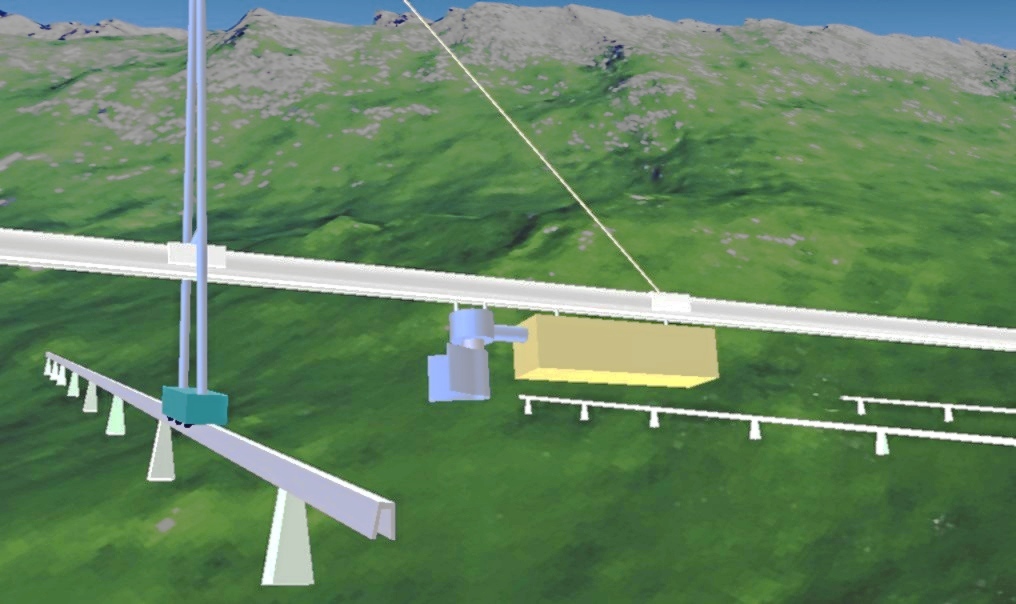Ground-scanning
Beamway for Energy Crops
by
Olav Naess
Harvesting Solar
Energy
Solar cells are fine for
collecting solar energy, but become expensive and obtrusive for large
scale energy harvesting.
Harvesting the energy
through plants, from which liquid fuel is produced, is likely to be
preferrable for large scale operation. Covering large areas with
solar cells will block and disturb human and animal activities,
unless the solar cell array can be placed in a desert, whereas an
energy crop area can be quite usable for people and animals if it is
designed following the guidelines outlined below. The natural energy
carrier from energy crops will be liquid fuel, which is the most
convenient energy carrier for vehicles.
Hydrogen is commonly
regarded as the energy source of the future: clean and CO2-neutral.
But hydrogen (for chemical combustion) is not an energy source, just
an energy carrier – like a copper cable is. And it is difficult
to store and transport, requiring either high pressure, supercooling,
or chemical binding which yields an awkward to handle solid, or at
best a liquid 3-4 times less energy efficient than gasoline or
diesel. Descriptions of chemical hydrogen binders generally disregard
the most efficient binder: carbon – evidently because the
carbon-hydrogen combinations are simply the old familiar fuels:
gasoline, diesel and (with a little oxygen added) alcohol. But when
the carbon is borrowed from the air, energy crop products like
biodiesel become CO2-neutral, consequently becoming valid
and efficient hydrogen economy products. A purism denouncing these
fuels will be just a stunt environmentalism.
It is now (in 2008)
common to reject fuel crop growing (like the bio-ethanol production
in Brazil, or the corn-based fuel production in the US) due to
present production methods consuming significant amounts of farmland,
farmer workpower, fertilizers and even production machinery fuel.
The purpose of this
article is to outline a production method which:
uses less energy –
because rail transport is far more energy efficient
needs no farm land
– because quite awkward terrain can be used
requires very
little farmer workpower – because computer controlled
machinery will do most of the work
can do without
fertilizers – because all harvested crops (minus the energy
and what the atmosphere later re-supplies) are brought back to the
fields
The energy crop plants
needn't be limited to the few species which presently seem to have
been chosen by farmer habits. Harvesting several meters above the
ground could for instance mean that the plants can be combination
plants: A bush or tree on the ground (the host plant) can have an
undisturbed root and leaf canopy, and other plants grafted on top of
it should just shoot energy rich stems upwards. The upper plant could
repeatedly be harvested by being cut a little above the grafting
point. It might be genetically modified to yield maximum energy
content, and might be unable to grow a root and procreate. Vegetable
oils are fuels which are simple to extract and use. The plants
yielding most of these oils are listed
here. Genes from one of the best of these plants might be
transferred to graftable plants in which the young stem could be
oil-producing. Gene manipulation is controversial when done in food,
but shouldn't be so problematic for energy crops, particularly if the
artificial plants lack a root.
If mangroves could be
used as host plants, biofuel could be produced in wetlands.
The object of the
following technique is: To enable energy-efficient and
computer-controlled access for machinery and crop containers to all
parts of the field to be cultivated, even if the terrain is quite
uneven.
Ground-scanning
with Beamway
Working
the earth by means of machines essentially implies XY-scanning the
two-dimensional surface like a computer printer/plotter does with a
sheet of paper. This work is traditionally done by moving the
machinery across an earth surface which, for the sake of work
efficiency, is quite flat, although the plants don't need this
flatness. In the contrary: A slope facing the sun would receive more
energy.
Transporting
passengers and goods is much more energy efficient on rail than on
roads, and the worst road is less energy wasting than the most level
soil. So why not do agriculture by means of an XY-scanning railway
which is elevated over that messy earth surface? The beamway,
as described in other articles on this website, is quite suitable for
this purpose.
 This
energy crop field on a sunny slope is harvested automatically by
XY-scanning railways. The two towers rolling upon the lower rails
hold the upper rail, a beamway as described in the beamway
introduction article. The machinery for harvesting (and otherwise
working) the fields are moving around computer-controlled like
beamway trains, along with connected crop container wagons. This
machinery should to some extent be able to move vertically, so that
it can deal with uneven terrain, and may then be compared with an XYZ
plotter.
This
energy crop field on a sunny slope is harvested automatically by
XY-scanning railways. The two towers rolling upon the lower rails
hold the upper rail, a beamway as described in the beamway
introduction article. The machinery for harvesting (and otherwise
working) the fields are moving around computer-controlled like
beamway trains, along with connected crop container wagons. This
machinery should to some extent be able to move vertically, so that
it can deal with uneven terrain, and may then be compared with an XYZ
plotter.
The
movable beam to the right has connected its left end to a switch
(which serves also the other adjacent rectangle), so that the
container on that beam can enter the external beamway running along
the lower part of the picture.
The
lower rails can have unlimited lengths, or they can, like in this
picture, go up a hillside, so that the movable upper rails, along
which there is more movement, can be more level. The lower rails are
held up by concrete pillars, 2-3 meters above the ground, so that
people and animals can pass freely across the fields.
In
wetlands, the lower rails may be omitted, and the upper rail can be
carried by floaters guided by cables running where the lower rail
would have been.
The
lower rails may seem to be monorails, but it would be more correct to
regard a pair of them as constituting a very wide-gauged standard
track, as the two bogies are connected (by a crossing, upper rail) to
act like one. When this wide bogie connects with the external
beamway, it should be skewed, so that only one end of the moving beam
contacts with the external beam. If there is little traffic on the
external beam, so that switching speeds are unimportant, a simplified
switching mechanism may be used: The end of the moving beam can push
aside the adjacent end of the external beamway beam in order to take
its line connection. The skewed position of the moving beam may be
permanent.
An
alternative method for connecting to the external beamway is: All the
movable beams are lined up with each other and with the end of the
external beamway.

The
harvester is ready, but the tall energy plants are not sown yet.
Working
from a beamway across the fields has several advantages:
The
field may be sloped, uneven, marshy, or simply a water surface.
Energy crops growing in water (e.g. like rice on terraces)
need not close their respiration pores to conserve water, so they
can avoid wasting their energy on breathing (destroying their
carbohydrate fuel) during nights.
Energy
plants need not be cut at the ground (coppicing),
but can be cut well above the ground (pollarding).
This
means various animals can live rather undisturbed on the ground,
and/or people can use the area as a park, walking on paths which
don't reduce the harvesting area. The leaves in a permanent canopy
enable the plants to rapidly grow the leafless new stems which are
ideal for energy harvesting.
Traffic
on elevated rails is simple to automatize, and doesn't conflict so
much with animal life.
If the machines work at night, it is
easier for their IR-detectors to detect the presence of body heat.
(And people using the area as a park are not much disturbed.)
If
there is a need for working the earth (plowing, tilling, root
removal, etc.) the beamway can't exert so much force as a tractor on
the ground, but it can use weaker tools and compensate by working
rapidly day and night. Also harvesting should be done steadily at a
low noise level, thus requiring small and simple machinery.
Crop
containers on the beamway can easily be sent to an industrial area
(with e.g. a power plant), moved by motorized bogies. They may spend
some time in front of parabolic mirrors – for sun energy
treatment like removing excess moisture.
The
masses remaining when the energy/fuel has been extracted, are likely
to be exactly what the plants need as fertilizer, so they are sent
back and spread on the field. A conventional ground-based harvesting
method is unlikely to do this properly and economically.
Energy
crops are likely to be in danger of crop field fires, but the
ground-scanning beamway system has unique potentials for firefighting
because its vehicles are always ready to go anywhere unmanned. One of
the extreme positions for the movable beam should be over a safe area
devoid of inflammable materials. This could be a road or a river, and
if there is a connection to an external beamway line, it should be in
this safe area. It should be possible for machines to suck up water
there and store it in standard crop containers. Then the beamway
vehicle could go for the flames like an over-sized ink-jet printer,
guided by IR-detectors in the top of one of its towers.
The
external beamway line is hopefully a useful line for other goods and
passenger transport purposes, so a large biomass processing system,
with extensive crop fields served by a large processing factory (or
power plant), should be quite economical.
3D
Landscape Printing
This
XYZ mechanism can also be used for shaping the landscape – just
like those 3D printers presently used for creating small objects.
But this beamway-based mechanism can be used on a much larger scale –
for building groups of houses. With "ink jets" for
concrete, sand, isolating foam and plastic materials, it can build
platforms, plumbing and walls, and then transport in beams and floor
plates to place upon the walls. The vegetation layout is of course
created by the same mechanism, also in gardens, verandas and on
roofs.
Copyleft
 Olav Næss
2006, 2008
Olav Næss
2006, 2008
 This
energy crop field on a sunny slope is harvested automatically by
XY-scanning railways. The two towers rolling upon the lower rails
hold the upper rail, a beamway as described in the beamway
introduction article. The machinery for harvesting (and otherwise
working) the fields are moving around computer-controlled like
beamway trains, along with connected crop container wagons. This
machinery should to some extent be able to move vertically, so that
it can deal with uneven terrain, and may then be compared with an XYZ
plotter.
This
energy crop field on a sunny slope is harvested automatically by
XY-scanning railways. The two towers rolling upon the lower rails
hold the upper rail, a beamway as described in the beamway
introduction article. The machinery for harvesting (and otherwise
working) the fields are moving around computer-controlled like
beamway trains, along with connected crop container wagons. This
machinery should to some extent be able to move vertically, so that
it can deal with uneven terrain, and may then be compared with an XYZ
plotter.